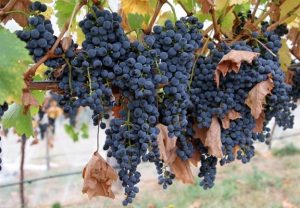The Syrah grape is ubiquitous. It originated in ancient Persia, around 4,500 years ago, according to archaeologists, in the region that now contains the city of Shiraz. And indeed, some wines made from the grape are still called Shiraz. It is now grown in France, mostly in the Rhône valley and the Languedoc. You’ll find it in California, especially in the Central Coast. It is a primary grape in Australian wines (where they call it Shiraz) with the center of production in the Barossa region.
We were first introduced to Syrah many years ago, when traveling in abroad. Some Aussie blokes we knew gave us a glass of Oxford Landing Shiraz. At that early stage of our wine tasting education, red wine meant Cabernet Sauvignon and nothing but. So our first reaction to this glass was that there was something wrong with the wine. But it wasn’t sour; it didn’t taste bad. It was just different. This was a wine tasting epiphany! Oxford Landing is a mass production wine and we’ve had many better Syrahs since then, but that first one has never been forgotten.
 Syrah grapes. Photo courtesy of Banfi Wines.
Syrah grapes. Photo courtesy of Banfi Wines.
One part of that experience still rings true: Syrah is different. Sometimes it’s a deep, dark wine that goes with roast beef. California’s Darioush winery makes wine like this. (The founder is of Iranian descent and calls it Shiraz.) Others are lighter and can accompany chicken or pasta. You just can’t tell until you taste.
Syrah is the primary grape of the Northern Rhône. Wines from Cornas must be 100% Syrah and it is central to most of the other wines of the region. There’s plenty of depth in these wines but there is also a notable acidity. As we have gone wine tasting in the Northern Rhône, we’ve been surprised at how notably acidic some of the wines are, especially those we tasted at Cave Yves Cuilleron. Of course, acidity is a good thing in wine; no complaints, we’re just noting the difference.
There’s plenty of Syrah grown in the Southern Rhône and the Languedoc, where it is generally blended with Grenache and other grapes. Blends are the rule for AOC-denominated wines, so single varietal wines from the region are marked as IGP (Indication Géographique Protégée) or VdP (Vin de Pays). When you can taste the full varietal character in the southern regions, there is often a note that the locals call garrigue, the scrubby vegetation that grows along the hillsides with some flavors of rosemary.
California’s Central Coast makes Syrahs that are fruit bombs with way over-the-top alcohol levels. Sometimes we call those “chewy” wines. In general, Syrah likes warm weather but the heat of the Central Coast really pumps up the sugar, which in turn becomes alcohol. The Syrahs in the Napa/Noma area tend to be mellower, though still on the deep end.
They grow more Shiraz in Australia than any other grape, and the wines tend to be big and sunny, which brings us full circle back to that first glass. The point of this round-the-world Syrah trip is that you never know what you’re going to get when you first taste a Syrah. Big and bold, lighter and acidic, punchy and alcoholic, open and herbal – they’re all the same grape, but not the same terroir, not the same winemaker.
So when you travel for wine tasting, be prepared for something different, whenever they offer you a Syrah.